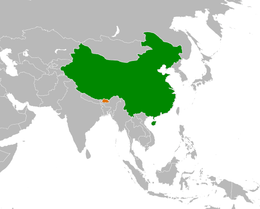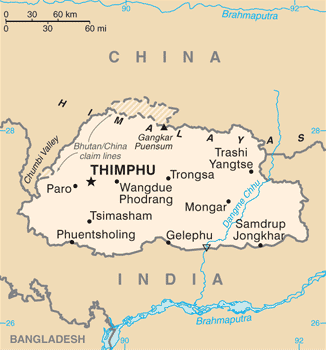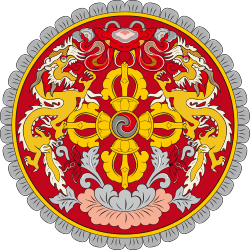Bhutan–China relations
The Kingdom of Bhutan and the People's Republic of China do not maintain official diplomatic relations, and relations are historically tense.[1][2][3] The PRC shares a contiguous border of 470 kilometers with Bhutan and its territorial disputes with Bhutan have been a source of potential conflict. Since the 1980s, the two governments have conducted regular talks on border and security issues aimed at reducing tensions.[1][2][3]
 | |
China |
Bhutan |
|---|---|
Background
Bhutan has long had strong cultural, historical, religious and economic connections to Tibet. Relations with Tibet were strained when Bhutan sided with the British Empire in its war with Tibet. Unlike Tibet, Bhutan had no history of being under the suzerainty of China, instead being under British suzerainty during the British Raj.
Bhutan's border with Tibet has never been officially recognized, much less demarcated. The Republic of China officially maintains a territorial claim on parts of Bhutan to this day.[4] The territorial claim was maintained by the People's Republic of China after the Chinese Communist Party took control of mainland China in the Chinese Civil War. With the increase in soldiers on the Chinese side of the Sino-Bhutanese border after the 17-point agreement between the Tibetan government and the central government of the PRC, Bhutan withdrew its representative from Lhasa.[4][5][6]
The 1959 Tibetan uprising and the 14th Dalai Lama's arrival in neighboring India made the security of Bhutan's border with China a necessity for Bhutan. An estimated 6,000 Tibetans fled to Bhutan and were granted asylum, although Bhutan subsequently closed its border to China, fearing more refugees.[4][7]
Border issues

- See also: Territorial disputes between the Kingdom of Bhutan and the People's Republic of China
Annexation of Bhutanese enclaves
In July 1959, along with the occupation of Tibet, the Chinese People's Liberation Army occupied several Bhutanese enclaves in western Tibet which were under Bhutanese administration for more than 300 years. These included Darchen, Labrang Monastery, Gartok and several smaller monasteries and villages near Mount Kailas.[8][9][10]
Chinese map claiming territories in Bhutan
A Chinese map published in 1961 showed China claiming territories in Bhutan, Nepal and the Kingdom of Sikkim (now a state of India).[4] Incursions by Chinese soldiers and Tibetan herdsmen also provoked tensions in Bhutan. Imposing a cross-border trade embargo and closing the border, Bhutan established extensive military ties with India.[4][5][5] During the 1962 Sino-Indian War, Bhutanese authorities permitted Indian troop movements through Bhutanese territory.[4] However, India's defeat in the war raised concerns about India's ability to defend Bhutan. Consequently, while building its ties with India, Bhutan officially established a policy of neutrality.[2][4] According to official statements by the King of Bhutan to the National Assembly, there are four disputed areas between Bhutan and China. Starting from Doklam in the west, the border goes along the mountain ridges from Gamochen to Batangla, Sinchela, and down to the Amo Chhu. The disputed area in Doklam covers 89 square kilometers (km2), while the disputed areas in Sinchulumpa and Gieu cover about 180 km2.[2]
Engagement
Until the 1970s, India represented Bhutan's concerns in talks with China over the broader Sino-Indian border conflicts.[2] Obtaining membership in the United Nations in 1971, Bhutan began to take a more independent course in its foreign policy.[4] In the U.N., Bhutan, incidentally alongside India, voted in favor of the PRC filling the seat occupied by the ROC and openly supported the "One China" policy.[2][3] In 1974 in a symbolic overture, Bhutan invited the Chinese ambassador to India to attend the coronation of Jigme Singye Wangchuk as the king of Bhutan.[2] In 1983, the Chinese Foreign Minister Wu Xueqian and Bhutanese Foreign Minister Dawa Tsering held talks on establishing bilateral relations in New York. In 1984, China and Bhutan began annual, direct talks over the border dispute.[2][5]
In 1998, China and Bhutan signed a bilateral agreement for maintaining peace on the border. In the agreement, China affirmed its respect for Bhutan's sovereignty and territorial integrity and both sides sought to build ties based on the Five Principles of Peaceful Co-existence.[2][3][5][11] However, China's building of roads on what Bhutan asserts to be Bhutanese territory, allegedly in violation of the 1998 agreement, has provoked tensions.[5][6][11] In 2002, however, China presented what it claimed to be 'evidence', asserting its ownership of disputed tracts of land; after negotiations, an interim agreement was reached.[2]
2010s
On 11 August 2016 Bhutan Foreign Minister Damcho Dorji visited Beijing, capital of China, for the 24th round of boundary talks with Chinese Vice President Li Yuanchao. Both sides made comments to show their readiness to strengthen co-operations in various fields and hope of settling the boundary issues.[12]
Doklam crisis, 2017
On June 29, 2017, Bhutan protested to China against the construction of a road in the disputed territory of Doklam, at the meeting point of Bhutan, India and China.[13] On the same day, the Bhutanese border was put on high alert and border security was tightened as a result of the growing tensions.[14] The Royal Government of Bhutan has not confirmed in any manner that Bhutan asked India to intervene.[15] A stand-off between China and India has endured since mid June 2017 at the tri-junction adjacent to the Indian state of Sikkim after the Indian army blocked the Chinese construction of a road in what Bhutan and India consider Bhutanese territory. Both India and China deployed 3000 troops on June 30, 2017.[16] On the same day, China released a map claiming that Doklam belonged to China. China claimed, via the map, that territory south to Gipmochi belonged to China and claimed that it was supported by the Convention of Calcutta.[17] On July 3, 2017 China told India that former Indian prime minister Jawaharlal Nehru accepted the Convention of Calcutta.[18] China claimed on July 5, 2017 it had a "basic consensus" with Bhutan and there was no dispute between the two countries.[19] On August 10, 2017 Bhutan rejected Beijing's claim that Doklam belongs to China.[20]
References
- A New Bhutan Calling (14 May 2008). OutlookIndia.com. Accessed 30 May 2008.
- "Bhutan-China Relations". Bhutannewsonline.com. 5 July 2004. Archived from the original on 27 December 2009. Retrieved 30 May 2008.
- Hussain, Wasbir (May 2007). "India and the upcoming Druk democracy". Himal Southasian. Archived from the original on 13 January 2008. Retrieved 30 May 2008.
- Savada, Andrea Matles (September 1991). Nepal and Bhutan : country studies. Library of Congress. pp. 330–333. ISBN 0844407771. Retrieved 30 May 2008.
- Balaji, Mohan (12 January 2008). "In Bhutan, China and India collide". Asia Times Online. Retrieved 30 May 2008.
- M Shamsur Rabb Khan (8 April 2008). "Elections in the Himalayan Kingdom: New Dawn of India-Bhutan Relations". Institute of Peace & Conflict Studies. Retrieved 29 May 2008.
- Bhutan: a land frozen in time (9 February 1998). BBC. Accessed 30 May 2008.
- Ranade, Jayadeva (16 July 2017). "A Treacherous Faultline". The Pioneer.
- K. Warikoo (2019). Himalayan Frontiers of India: Historical, Geo-Political and Strategic Perspectives. 149: Routledge. p. 240. ISBN 9781134032945.CS1 maint: location (link)
- Arpi, Claude (16 July 2016). "Little Bhutan in Tibet". The Statesman.
- Bhutan Gazette (7 June 2007). BhutanGazette. Accessed 30 May 2008.
- "China hopes to forge diplomatic ties with Bhutan". Xinhua News. Retrieved 29 September 2016.
- "Bhutan protests against China's road construction". The Straits Times. 30 June 2017. Retrieved 30 June 2017.
- "Bhutan issues scathing statement against China, claims Beijing violated border agreements of 1988, 1998". Firstpost. 30 June 2017. Retrieved 30 June 2017.
- "Wangcha Sangey". wangchasangey.blogspot.com.
- "Border face-off: China and India each deploy 3,000 troops - Times of India". Retrieved 6 July 2017.
- "EXCLUSIVE: China releases new map showing territorial claims at stand-off site". Retrieved 6 July 2017.
- "Nehru Accepted 1890 Treaty; India Using Bhutan to Cover up Entry: China". Retrieved 6 July 2017.
- PTI (5 July 2017). "No dispute with Bhutan in Doklam: China". Retrieved 6 July 2017 – via The Economic Times.
- PTI (10 August 2017). "Bhutan rejects China's claim in Doklam: China". Retrieved 10 August 2017 – via The Economic Times.

.svg.png)